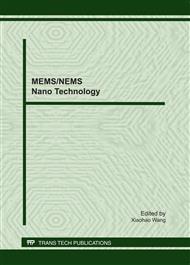p.635
p.643
p.647
p.653
p.658
p.663
p.668
p.674
p.679
Molecular Dynamics Study of Water Structure Confined in Vibrative Silicon Plates
Abstract:
A physical model of the bulk-nanochannel-bulk with buffer bathes has been set up in this paper using molecular dynamics (MD) simulation. The distribution of water molecules and counterions Na+ in the nanochannel region with different surface charge densities is studied when silicon atoms vibrate. Simulation results show that the interaction between the charged surfaces and the ions in the channel results in an enrichment of counterions. With the increase of the surface charge density, the vibration effect of silicon atoms on the distribution of water molecules and Na+ ions cannot be ignored, which results in the decreasing of adsorbed peak and increasing of the first hydration peak. The concentration of Na+ increases and it distributes farther away from the wall. In addition, the ion exchange between nanochannel region and bath boxes is considered, so it is not electrical neutrality in the nanochannel region, and its electrical property depends on the surface charges.
Info:
Periodical:
Pages:
658-662
Citation:
Online since:
June 2011
Authors:
Keywords:
Price:
Сopyright:
© 2011 Trans Tech Publications Ltd. All Rights Reserved
Share:
Citation:


